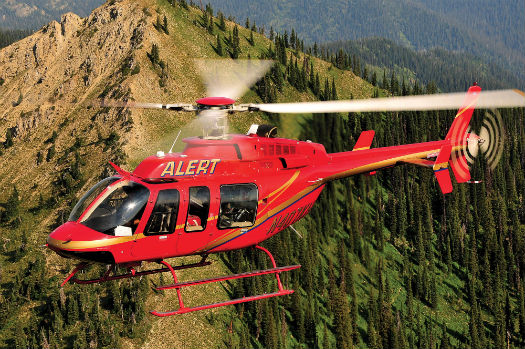
Montana is a diverse state, with an enormous variety of terrain over which to fly. ALERT has been providing air medical support to the state’s northwest for almost 40 years.
The Advanced Life-support and Emergency Rescue Team (ALERT) has been saving lives in rugged northwest Montana for almost 40 years. The region it serves — a ring roughly 150 nautical miles out from its base at Kalispell Regional Medical Center in Kalispell, Mont. — is an adventurer’s paradise, with three million acres of wilderness in which residents and visitors can play, explore, or escape. Kalispell itself has a population of about 20,000, but as the retail, professional, medical and governmental center of the Flathead Valley, it serves approximately 140,000 people in Northwest Montana — and the region’s beautiful national parks and spectacular scenery also attract millions of visitors each year.
For the ALERT helicopter emergency medical services (HEMS) program, this environment creates a challenging mix of calls for help — from injuries caused by watersports or off-road motorcycling, to responding to a bear mauling, or completing a post-avalanche search.
Established in September 1975, ALERT is one of the oldest hospital-based HEMS programs in the United States. The program came to being following the death of a 26-year-old logger. The man had been seriously injured working in a remote and inaccessible area, and while a privately-owned helicopter was able to rescue him and transport him to a hospital, it had no medical crew on board. With no ability to treat him during the flight, the efforts to save his life were sadly in vain. His death deeply affected his employer, and he and other loggers pushed the local medical community to establish an air ambulance service to provide care to the local population.
Today, ALERT’s rotary-wing service — consisting of a single Bell 407 — handles an average of 345 emergency transports each year.
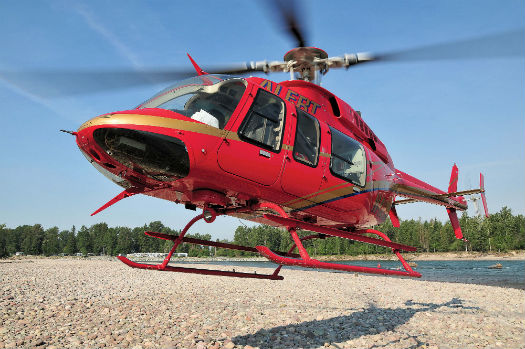
Responding to water injuries is a common requirement for ALERT during the warm summer months.
Operational challenges
“We cover a large area of northern Montana including outlying towns, ranches, highways and Indian reservations including both the Blackfeet and Flathead tribes,” Carson Coryell, ALERT’s director of operations, told Vertical. “With so much remote area, for the most part, we’re the only way to get emergency medical care quickly to people.”
Being a rural program, ALERT’s missions are split 60/40 between scene calls and interfacility transfers.
During the summer months, scene calls are often in response to accidents caused by the wide range of water sports on offer, or hiking, climbing, off-roading, or horseback riding. Flathead Lake — the largest natural, freshwater lake west of the Mississippi — is in ALERT’s operational area, and it caters to many boaters, water skiers, swimmers, divers, and fishing enthusiasts. This means that responses to drownings, head injuries and other water-related traumas are common, requiring ALERT’s 407 to routinely land on beaches, islands and riverbeds.
The summer months see a large increase in the number of people on the roads, so there is also an increase in motor vehicle and motorcycle accidents. Motorcycle accidents, in particular, tend to be very serious, so HEMS transport can be critical for the victim’s survival because of the sheer remoteness of where they can take place.
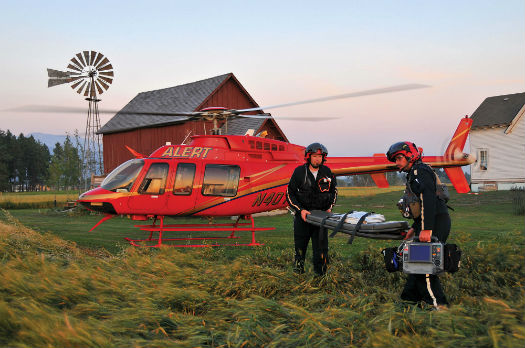
With many farms and ranches in its region of coverage, ALERT performs numerous off-site landings.
The summer temperatures can also present a challenge, with highs above 90 F (32 C) matched with requests to land at over 8,000 feet (2,438 meters) or higher density altitudes. “We do many flights into the higher elevations, because this is where many people tend to go for their recreational needs,” said Justus. Snake bites, bee and wasp attacks, and other interactions with wild animals bring ALERT into action on a routine basis — over the years, the program has had to respond to astonishing 32 bear maulings in its local operating area. “We need to be very aware of our surrounding when we land in remote area because of the bear threat,” Justus added.
During winter operations, temperatures can drop to well below freezing. During these times, the aircraft and crew carry additional cold weather survival equipment, including snow shoes, jackets, sleeping bags, fire-starting gear, shovels and probe poles, survival food and water. “Most of Montana is very remote,” said Justus. “When we fly long legs we might see very little civilization and need to be prepared to wait some time for help if we need to land unexpectedly.”
Winter scene calls can include responding to remote snowmobile, skiing, or snowboarding accidents, as well as dealing with the results of an avalanche.
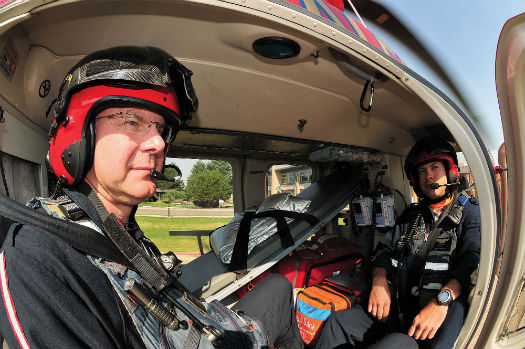
The Bell 407’s cabin may not be overly large, but it’s adequate for single-patient transports.
The right equipment
ALERT has been a Bell Helicopter operator since its inception. It began with a Bell 206 JetRanger (originally leasing the aircraft before it purchased its own in 1980), but while the crews found the JetRanger worked well to get the program on its feet, it had performance limitations and a cabin that wasn’t optimal for HEMS operations. In 1987, the JetRanger was traded for a Bell 206 L-3 LongRanger, which provided a larger cabin for patient care and allowed the medical crew to move around. The L-3 also had considerably more power, allowing the team to retrieve patients at higher altitudes with more safety. The LongRanger served for 13 years and completed over 5,000 flight hours before it was eventually replaced with the program’s current aircraft — the Bell 407.
“The 407 is an excellent machine that is small enough to fit into tight landing zones, and has a strong and reliable engine,” ALERT rotary-wing chief pilot Ken Justus told Vertical. “[It] has also given us another 25 knots of forward airspeed over the LongRanger.”
The 407 is equipped with BendixKing radios, SkyTrac satellite tracking and sat-phone, a traffic collision avoidance system, and a Garmin 530W HTAWS. The cockpit is also fully compatible with night vision goggles (NVGs). During the winter months, the aircraft’s engine is protected by snow baffles and its skids have bear paws.
On a single load of fuel, the helicopter’s out-and-back range is about 125 miles — but with refueling it can travel as far as is needed.
For longer flights, ALERT operates a pair of Pilatus PC-12s that provide the range to serve patients’ medical needs not only in Montana, but also in neighboring states. One of the PC-12s is used for patent transports while the other is used as an outreach aircraft, transporting specialized doctors around the state to serve small towns and villages.
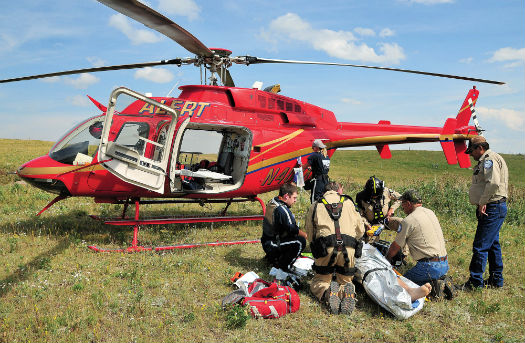
The ALERT medical team attends to a patient next to the team’s Bell 407.
Looking at future aircraft options, ALERT’s pilots said they were happy with Bell products and have looked at the twin-engine Bell 429 with its larger cabin. But, more realistically, an upgraded Bell 407GX is probably the more feasible aircraft. “We have been totally happy with the 407,” said Justus. “It does what we need it to do and it’s an airframe we know and trust.”
Because ALERT is a single-aircraft program, keeping the Bell 407 flying is of utmost importance. It uses a Federal Aviation Administration approved aircraft inspection program (AAIP) for the aircraft’s maintenance. “Our AAIP is based on the aircraft manufacturer’s progressive maintenance program, but is customized for our use,” said mechanic Brett Reilly. To prevent extended downtime, the inspection program is broken into six events, with each one covering a different section of the aircraft. The events are conducted at 50-hour intervals, so all six are completed in 300 hours. According to Reilly, most events can be completed in less than a day.
All supplemental equipment installed on the aircraft is included in ALERT’s AAIP and have specific inspection intervals that coincide with a certain event. All “time life” components are removed and replaced or overhauled as directed by the aircraft manufacturer. “Overall we have found that using this inspection program keeps our availability rate higher, with less downtime due to lengthy inspection periods,” said Reilly.
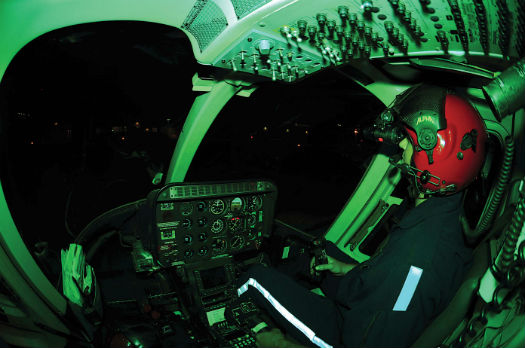
Night vision goggles have brought a new level of safety to ALERT’s operations.
Making the team
ALERT employs five full-time pilots to fly the 407. “Pilots that fly here enjoy the autonomy and the sheer beauty of where we operate,” said Justus. “I know I’m spoiled living here, but being able to fly over and see what I see every day is a true gift — and never gets old.”
Perhaps because of this, it’s not an easy job to land. New pilot hires are required to have at least 2,500 hours total flight time (with 100 of those completed at night), as well as experience flying in a mountain environment. Time in a JetRanger, LongRanger or 407 is desirable, and NVG experience is a plus, but is not a pre-requisite (NVG training is provided). Justus said NVGs have become an integral part of ALERT’s operations.
“NVGs are a game changer up here, especially on dark nights — of which there are many. They have immeasurably increased the safety margins that we fly and have lowered the fatigue factor on the longer night flights,” he said.
He added that while the natural beauty of the area makes the flying spectacular, the remoteness of much of it makes ALERT’s work challenging. “Trying to find people who aren`t sure where they are can be difficult,” he said. “At night, it’s even more of a challenge, but now that people have cellphones, the light from them makes it easy to locate them when [using] NVGs.”
In the cabin, ALERT’s flight crew consists of a nurse and a paramedic. “We felt this configuration was best as it gives us a breadth of experience,” said flight nurse Hank Dietrich. “The paramedic has the field and on-scene medical experience, while the nurse has the more in-depth medical- and drug-related experience.”
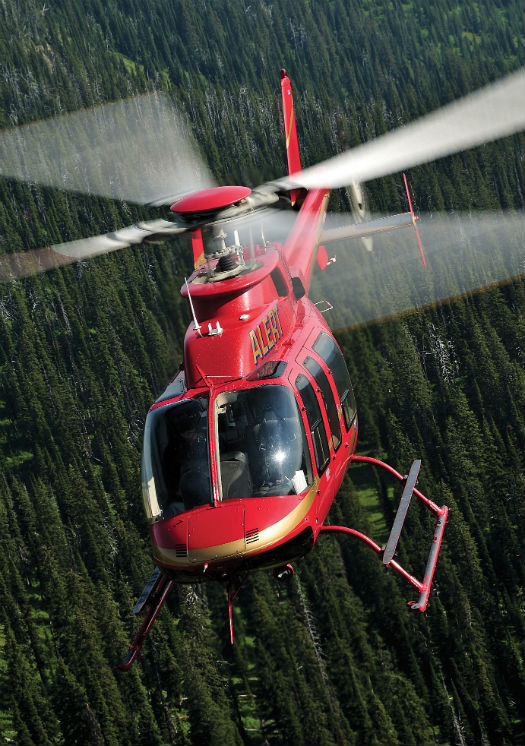
ALERT has completed more than 15,000 flights during its 40 years of operation.
There are seven members of each discipline in the full-time flight crew staff, and they are augmented with part-time staff. The program also has specialty teams available for neonatal intensive care unit and pediatric transports.
The medical crew’s typical missions include medical and trauma responses — either directly at an accident scene, or meeting an ambulance or sheriff with the patient at a designated landing zone nearby. Interfacility flights are normally to outlying clinics, or hospital to hospital transfers — such as critical care transports, or obstetrical or neonatal isolette transfers. ALERT also responds to requests for search-and-rescue (SAR). “During the winter months, it’s important to find lost people [quickly] because of the low temperatures and the possibility of frostbite or freezing to death,” said flight paramedic Chris Sobin.
In addition to what might be considered the “standard” advanced life support and critical care equipment carried by the ALERT 407, it has specialized equipment in the form of an airframe-mounted Barryvox avalanche beacon search system, a Skedco field stretcher, and a life ring and line for water rescues. “We really have to be prepared for anything out here, as the next rescue capability might be hours away,” said Sobin.
Since 1975, ALERT has completed more than 15,000 flights, saving thousands of lives in the some of the most challenging locations in the U.S. “ALERT has been here for the last 40 years, and we hope to be here for the next 40 serving the people of the great state of Montana,” said Justus.





